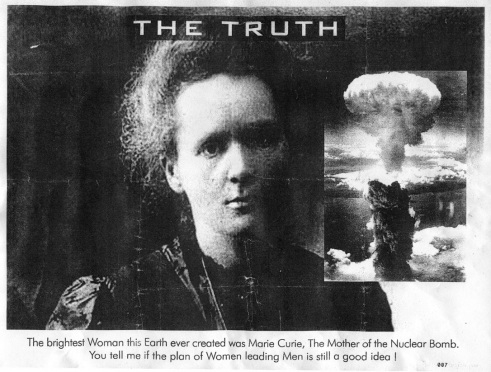In The Fourteen Not Forgotten and Sexist Posters at Waterloo, Christine Cheng discusses a misogynist activist at the University of Waterloo who put up fourteen posters last month (February 2011) vilifying scientist Marie Curie and women in general. (Her post is also cross-posted at the Geek Feminism Blog.)

The incident reminds many of us of the École Polytechnique Massacre. Both the University of Waterloo and l’École Polytechnique de Montréal focus on STEM (Science, Technology, Math, and Engineering) fields, and female students are a minority. Both schools are located in Canada. Both misogynists appear to be angry that women are attending university and are being educated in male-dominated fields.
The Marie-Curie-hating misogynist at Waterloo has also sent out a misogynist e-mail pretending to be the university’s president, and has created a Facebook page with similar misogynist rantings. The university’s Women’s Centre and LGBT student centre have closed due to safety concerns.
A male undergraduate at the University of Waterloo made this ridiculous—yet typical male-privileged—comment before taking down his post:
Yes, it is wrong, yes, it is inappropriate, but get a life if you are going to fuss and cry over stupid shit like this. Because if you do, you must be living in a sheltered bubble.
A commenter at hook & eye named bakka111 responds to this reaction:
The “Sheltered bubble” comment from Bill’s portfolio is particularly ironic. Just who lives in a sheltered bubble? Those who fear the messages because they have experienced the mundane-threats a patriarchal culture issues to women, or those who have never experienced such threats. Oh the irony.
Further Reading:
- The Fourteen Not Forgotten and Sexist Posters at Waterloo by Christine Cheng
- the honest truth: Marie Curie, in which one learns that double-Nobel-prize-winning Marie Curie received her education at an “underground university”, because conventional universities did not accept women. Imagine what the history of science would look like if women were not barred from university.

